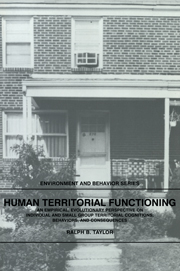 Human Territorial Functioning
Human Territorial Functioning The major themes of this volume are captured in the subtitle: the evolutionary origins of protohuman and later human territorial functioning. For such a system to have survived, albeit significantly altered, it must have “benefits” for humans. I suggest that it does; territorial functioning has psychological, social psychological, and ecological outcomes that contribute to orderly person–place relationships and to the well-being of individuals and small groups. My treatment of human territorial functioning is grounded in empirical social science research. Consequently, I circumscribe the concept to microscale, usually delimited locations ranging in size from furnishings (e.g., a chair) up to the scale of a streetblock. I maintain, based on theory and lack of evidence, that the concept does not work well when applied to macroscale settings, such as neighborhoods or nations.
The reader may think this treatment of the concept too confining or specialized. Nonetheless, the confusion surrounding the concept of human territoriality will be reduced only if we look carefully at how empirical findings illuminate the concept. And, the findings simply do not extend to larger-scale settings than the ones discussed here. I admit that my view is at variance with the perspective of other writers on this topic.
In addition, whereas others, from Klineberg, who discussed an instinct or drive for possessiveness, to Malmberg, who more recently placed the territorial instinct in the limbic system, have viewed teritorial functioning as instinct-based or “hard-wired,” I attempt to show that it is, rather, a set of learned, goal-oriented processes.
To save this book to your Kindle, first ensure [email protected] is added to your Approved Personal Document E-mail List under your Personal Document Settings on the Manage Your Content and Devices page of your Amazon account. Then enter the ‘name’ part of your Kindle email address below. Find out more about saving to your Kindle.
Note you can select to save to either the @free.kindle.com or @kindle.com variations. ‘@free.kindle.com’ emails are free but can only be saved to your device when it is connected to wi-fi. ‘@kindle.com’ emails can be delivered even when you are not connected to wi-fi, but note that service fees apply.
Find out more about the Kindle Personal Document Service.
To save content items to your account, please confirm that you agree to abide by our usage policies. If this is the first time you use this feature, you will be asked to authorise Cambridge Core to connect with your account. Find out more about saving content to Dropbox.
To save content items to your account, please confirm that you agree to abide by our usage policies. If this is the first time you use this feature, you will be asked to authorise Cambridge Core to connect with your account. Find out more about saving content to Google Drive.